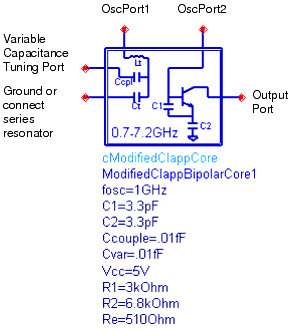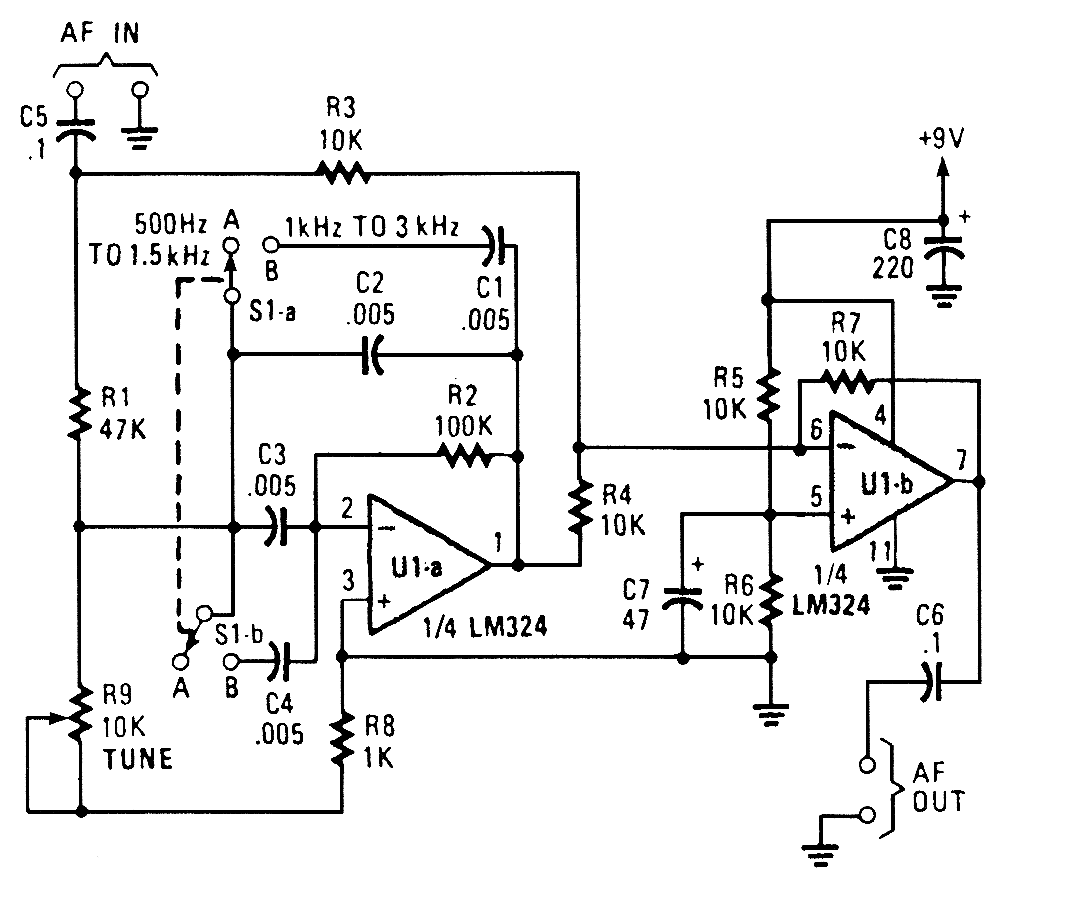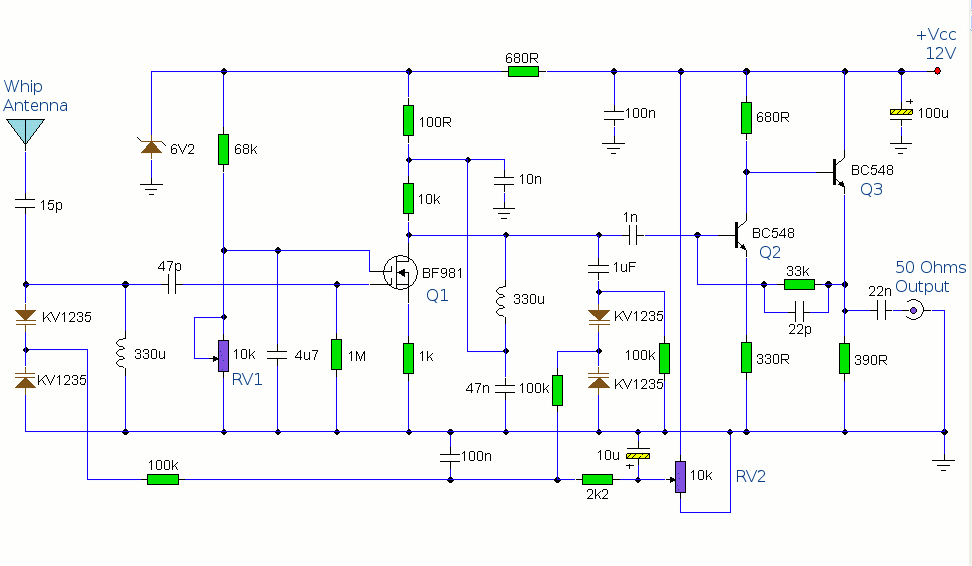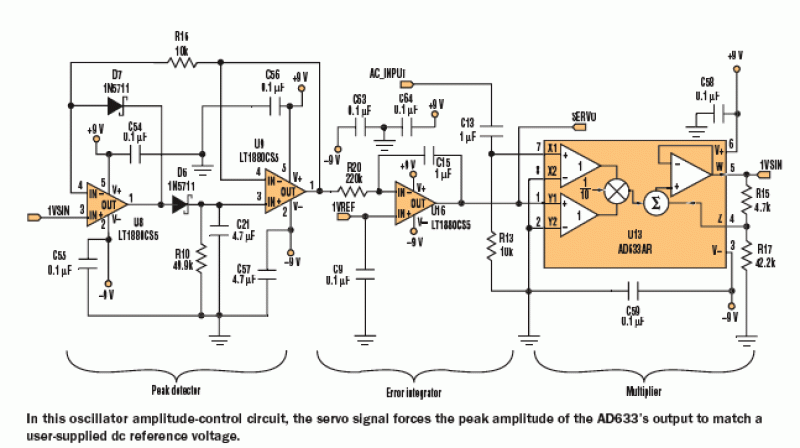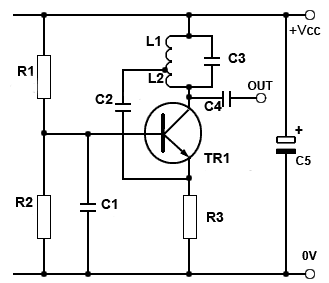
triangular wave oscillator
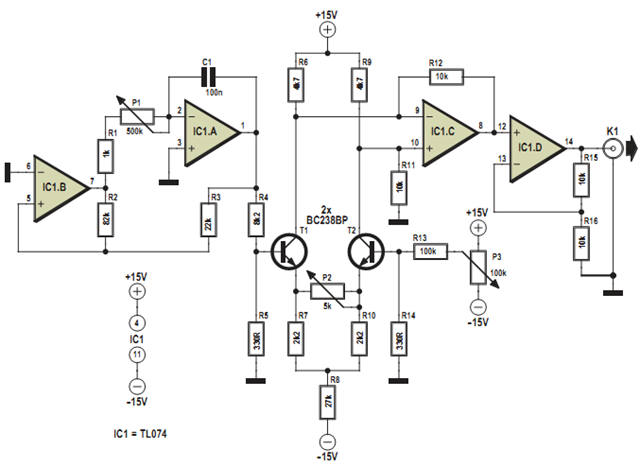
This design was developed to partially replace the well-known 8038 chip, which is no longer in production and therefore difficult to obtain. An existing design for driving a Linear Variable Differential Transformer (LVDT) sensor utilized the 8038 as a variable sine wave oscillator and required modernization. Although it might have been feasible to substitute the 8038 with an Exar 2206, this alternative was incompatible with the supply voltage in use. Consequently, a replacement was sought using standard components that remain readily available. In this circuit, two operational amplifiers from a TL074 (IC1. A and B) are employed to generate a triangular wave with a frequency adjustable over a wide range via potentiometer P1. The subsequent differential amplifier, using transistors T1 and T2, is configured to convert the triangular waveform into a well-defined sinusoidal waveform. Potentiometer P2 is utilized to minimize distortion. The third operational amplifier (IC1. C) is set up as a difference amplifier, providing the sine wave output. This signal is then buffered by the final operational amplifier (IC1. D). Any offset at the output can be nullified using potentiometer P3.
The described circuit serves as a modern alternative to the obsolete 8038 chip, focusing on the generation of sine wave signals suitable for driving LVDT sensors. The use of the TL074 operational amplifier is advantageous due to its availability and versatility. The configuration begins with two op-amps (IC1. A and B) configured as integrators to produce a triangular waveform. The frequency of this waveform is adjustable through the potentiometer P1, allowing for a range of operational frequencies based on the application requirements.
The triangular wave is then fed into a differential amplifier stage composed of transistors T1 and T2, which shapes the waveform into a sine wave. This stage is crucial for reducing the harmonic distortion inherent in triangular waveforms, thereby enhancing the signal quality for sensitive applications such as LVDT sensors. Potentiometer P2 allows for fine-tuning of this distortion, ensuring that the output waveform closely resembles a pure sine wave.
The output from this differential amplifier is processed by a third op-amp (IC1. C) configured as a difference amplifier, which effectively presents the sine wave at its output terminal. This configuration provides the necessary gain and isolation from the previous stages. Finally, the output is buffered by the last op-amp (IC1. D) to ensure that the signal can drive subsequent circuitry without loading effects. The inclusion of potentiometer P3 allows for the adjustment of any DC offset at the output, ensuring that the signal remains centered around the desired voltage level. This comprehensive approach to circuit design not only modernizes the original application but also maintains compatibility with standard components, ensuring long-term availability and support for future designs.This design resulted from the need for a partial replacement of the well-known 8038 chip, which is no longer in production and there fore hardly obtainable. An existing design for driving an LVDT sensor (Linear Variable Differential Transformer), where the 8038 was used as a variable sine wave oscillator, had to be modernised.
It may have been pos sible to replace the 8038 with an Exar 2206, except that this chip couldn`t be used with the supply voltage used. For this reason we looked for a replacement using standard components, which should always be available.
In this circuit two opamps from a TL074 (IC1. A and B) are used to generate a triangular wave, which can be set to a wide range of frequencies using P1. The following differential ampli ¬er using T1 and T2 is con ¬gured in such a way that the triangular waveform is converted into a reasonably looking sinusoidal waveform.
P2 is used to adjust the distortion to a minimum. The third opamp (IC1. C) is configured as a difference ampli ¬er, which presents the sine wave at its output. This signal is then buffered by the last opamp (IC1. D). Any offset at the output can be nulled using P3. 🔗 External reference
The described circuit serves as a modern alternative to the obsolete 8038 chip, focusing on the generation of sine wave signals suitable for driving LVDT sensors. The use of the TL074 operational amplifier is advantageous due to its availability and versatility. The configuration begins with two op-amps (IC1. A and B) configured as integrators to produce a triangular waveform. The frequency of this waveform is adjustable through the potentiometer P1, allowing for a range of operational frequencies based on the application requirements.
The triangular wave is then fed into a differential amplifier stage composed of transistors T1 and T2, which shapes the waveform into a sine wave. This stage is crucial for reducing the harmonic distortion inherent in triangular waveforms, thereby enhancing the signal quality for sensitive applications such as LVDT sensors. Potentiometer P2 allows for fine-tuning of this distortion, ensuring that the output waveform closely resembles a pure sine wave.
The output from this differential amplifier is processed by a third op-amp (IC1. C) configured as a difference amplifier, which effectively presents the sine wave at its output terminal. This configuration provides the necessary gain and isolation from the previous stages. Finally, the output is buffered by the last op-amp (IC1. D) to ensure that the signal can drive subsequent circuitry without loading effects. The inclusion of potentiometer P3 allows for the adjustment of any DC offset at the output, ensuring that the signal remains centered around the desired voltage level. This comprehensive approach to circuit design not only modernizes the original application but also maintains compatibility with standard components, ensuring long-term availability and support for future designs.This design resulted from the need for a partial replacement of the well-known 8038 chip, which is no longer in production and there fore hardly obtainable. An existing design for driving an LVDT sensor (Linear Variable Differential Transformer), where the 8038 was used as a variable sine wave oscillator, had to be modernised.
It may have been pos sible to replace the 8038 with an Exar 2206, except that this chip couldn`t be used with the supply voltage used. For this reason we looked for a replacement using standard components, which should always be available.
In this circuit two opamps from a TL074 (IC1. A and B) are used to generate a triangular wave, which can be set to a wide range of frequencies using P1. The following differential ampli ¬er using T1 and T2 is con ¬gured in such a way that the triangular waveform is converted into a reasonably looking sinusoidal waveform.
P2 is used to adjust the distortion to a minimum. The third opamp (IC1. C) is configured as a difference ampli ¬er, which presents the sine wave at its output. This signal is then buffered by the last opamp (IC1. D). Any offset at the output can be nulled using P3. 🔗 External reference
